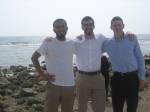The Kingdom – Part 2
After a day of the standard Ministry itinerary in Jeddah–a visit to the breathtaking King Abdullah University of Science and Technology (KAUST)–the group was a bit tired of following the road most traveled. With a bit of finagling, we convinced Saad, one of our guides form the Ministry, to show us more of the city than the extravagant university it had to offer. In our gender-separated cars, we drove around old Jeddah. The neighborhood was an amalgam of dilapidated buildings and litter-strewn alley ways, with pockets of the ancient, pure beauty of a time past peaking through around each corner. Saad informed us that many Muslims who had come to Saudi Arabia for the hajj decided to remain in this part of the city, drawn to the quiet holiness of the cobblestone streets.
 A brief ride through the old city was followed by a trip to the Red Sea. We approached the rocky shore to put our toes in the warm water. Professor David skipped stones into the sea while Bayly followed his usual protocol and struck up a conversation with a Saudi local. The breeze emanating from the water was a nice repose from the usual thick heat I felt walking through the city in my abaya.
A brief ride through the old city was followed by a trip to the Red Sea. We approached the rocky shore to put our toes in the warm water. Professor David skipped stones into the sea while Bayly followed his usual protocol and struck up a conversation with a Saudi local. The breeze emanating from the water was a nice repose from the usual thick heat I felt walking through the city in my abaya.
We soon departed the Red Sea and Jeddah altogether. We returned to the Al Faisaliah Hotel to find our friends from the King Abdul Aziz Center for National Dialogue waiting for us. They took us to the mall for traditional Arab food, plates upon plates of taboulleh, stuffed grape leaves, hummus, and shwarma. The meal was a delicious end to an exciting day, but what made it all the more rewarding was the conversation we had with the students.
In Saudi fashion the boys gravitated to their own gender, as did the girls. Hannah and I spoke to the two female students who were there, both interested in discussing American values and Saudi values. One female student, Najla, was getting her MBA from UNC-Chapel Hill while her friend Hawra, who had lived in the US for most of her life, was just finishing up work in Saudi Arabia and hoping to continue her studies. Both girls were impressive in their own right, and the ease with which they communicated in English was yet another testament to their acumen.
The debate over restrictions on women driving (which the two girls agreed was an arcane and unfair law) turned into a discussion on the abaya, a far more contentious issue. For Najla, the abaya is a symbol of her religious values and Saudi culture. Studying in the United States, she feels lonely in its absence, and often wears it as a comfort, a reminder of home. She does not feel constrained by her modesty and informed us that if her husband were to ask her to further cover herself, she would consent wholeheartedly, not because she felt objectified, but because she respected his desires. Hawri, on the other hand, could not feel more differently. She sees the burka as a way of men controlling women and looks forward to a time when women can openly discuss the issue and choose to wear what they feel is appropriate for themselves.
 It was difficult for me to listen to Najla’s words and not feel a hint of sorrow. I can’t help thinking (admitting the biases that the Western world has instilled in me) that a woman as remarkable as her is suppressed by the society she calls home. But, Hawri proved to me that Najla’s stance is not the only one that exists in Saudi Arabia. At the very least, I am happy knowing that these issues are now being raised and debated. I foresee changes that might occur as more and more women become educated and are exposed to other countries that allow their women to wear what they choose. Like Hawri, I have hopes for the future of Saudi women and the country as a whole. Inshallah.
It was difficult for me to listen to Najla’s words and not feel a hint of sorrow. I can’t help thinking (admitting the biases that the Western world has instilled in me) that a woman as remarkable as her is suppressed by the society she calls home. But, Hawri proved to me that Najla’s stance is not the only one that exists in Saudi Arabia. At the very least, I am happy knowing that these issues are now being raised and debated. I foresee changes that might occur as more and more women become educated and are exposed to other countries that allow their women to wear what they choose. Like Hawri, I have hopes for the future of Saudi women and the country as a whole. Inshallah.
-Briana Last

Leave a comment